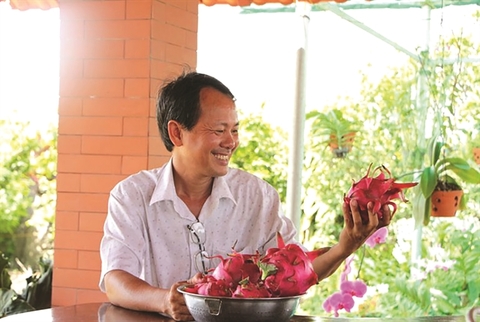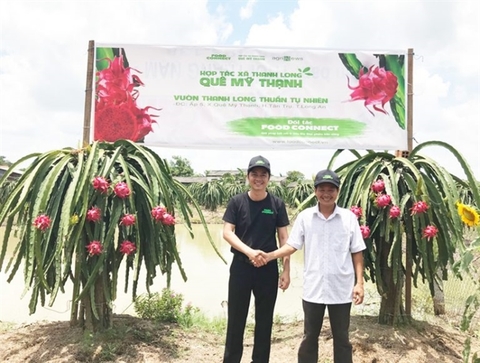
An organic red-flesh dragon fruit orchard in Long An Province’s Chau Thanh District. The fruit is a popular variety grown in the districts Chau Thanh, Tan Tru and Thu Thua and Tan An City in Long An Province. — VNA/VNS Photo Bui Giang
Digital transformation in agriculture increases production efficiency and offers consumers greater transparency about food products. However, progress remains sluggish in Viet Nam, and more research is needed. Bo Xuan Hiep reports.
Farmer Le Van Chin from the southern province of Long An recently livestreamed an advert about his cooperative’s red-flesh dragon fruit on his Facebook page.
“Hi everyone! Here is the dragon fruit garden of Que My Thanh Cooperative. After 25 days of harvest, it has a thin peel and red flesh. Rest assured we never use any harmful chemicals to spray the fruit. We guarantee that it is healthy and tasty,” he told viewers.
“I livestream various stages such as farming, harvesting and packaging to create consumer confidence about my product,” he said.
Amid the COVID-19 pandemic, Chin was one of thousands of farmers who decided to sell directly on social network sites such as Facebook, Zalo and others.
No official statistics about the number of farmers using livestreaming exist, but it has become increasingly common. Livestreams on social networks and e-commerce platforms in Viet Nam have attracted hundreds of thousands of views a day.
Nguyen Duc Tung, general secretary of the Viet Nam Digital Agricultural Association, said that more farmers were selling online directly to consumers without intermediaries, which has helped lower prices.
To do business online, farmers had learned more about photography, sales and communication skills to engender trust among consumers, he said.
According to Nguyen Manh Tan, marketing director of Haravan, which provides e-commerce and retail solutions, farmers only need a smartphone and Facebook account to conduct a livestream.
Selling on Facebook or Zalo is easier than on e-commerce platforms, which have more requirements such as packaging specifications and legal conditions.
Since packaging, storage and transport can be done better by distributors, farmers often livestream their products directly from their fields or gardens to distributors.
Despite online trends, a number of high-quality, affordable agricultural products that meet export standards are still absent on major e-commerce platforms such as Tiki, Sendo and Voso.
One of the main reasons for the low consumption of “clean” agricultural products on e-commerce platforms is the life cycle of the product.
Vu Kim Hanh, chairwoman of the High Quality Vietnamese Product Business Association, said that fresh agricultural products were less popular on e-commerce sites because the life cycle was too short.
Nguyen Dac Viet Dung, chairman of the board of directors of Sen Do Joint-Stock Company, said if the life cycles could be extended, buyers would feel more secure about purchasing organic or clean products on e-commerce sites.
Digital transformation

Farmer Le Van Chin, director of the Que My Thanh Dragon Fruit Cooperative, wants to offer "clean” dragon fruit to customers across the country. — Photo courtesy of Que My Thanh Dragon Fruit Cooperative
Farmer Chin, who is the director of the Que My Thanh Dragon Fruit Cooperative in Long An Province’s Tan Tru District, decided to shift his family’s four-hectare red-flesh dragon fruit garden to a natural direction without using chemicals, and embrace digital technology.
“I have gradually shifted to organic fertiliser and bio-products to grow quality dragon fruit and use efficient irrigation methods like automatic spraying and drip irrigation to save water.”
Chin is one of the partner farmers of Food Connect, a project of the Food Network Joint-Stock Company, that aims to link farmers with consumers through technology platforms.
Under the project, training sessions on e-commerce and transparent production processes are provided to farmers to help them save costs by avoiding a middleman, thereby reducing prices for consumers.
The cooperative, which has 22 hectares of cultivated dragon fruit, sells its products to fruit chains across the country.
“Despite their somewhat ugly appearance and shape, the fruit is popular with local consumers because of the quality. Also the first batch of dragon fruit was exported to Dubai,” Chin said. “Consumers can scan the QR code on the product to know the exact origin.”
Dr Tu Minh Thien, rector at Van Hien University in HCM City, said the use of advanced technology had contributed to nearly 35 per cent of the growth value of agriculture in Viet Nam in the last five years.
In the field of irrigation, drip, sprinkler and underground irrigation systems are being used on different terrains, making watering more accessible. Such systems are typically attached to a flow controller which provides fertiliser for crops.
Techniques from the biotechnology field are also being used in farming, such as gene mapping of plants. Advanced techniques such as ELISA and PCR are used in the diagnosis and identification of viral diseases of plants.
In wet-rice production, biotechnology is also being used to breed rice varieties, with slow-soluble fertilisers and saltwater warning systems in Soc Trang, Dong Thap, and Tra Vinh provinces.
“Biotechnology applications are an effective solution for sustainable agriculture and for limiting the impact of climate change,” Dr Thien said.
Blockchain is another technology that is being used in product traceability and supply chain management in Long An, Tien Giang, Dong Thap and other provinces.
In Dong Thap and Ben Tre provinces, technological advances have improved the monitoring of automatic irrigation systems by quickly identifying the watering level of a tree, for example, and alerting farmers to the exact location of the water shortage area.
The systems, which use GPS and automatic routing to cover an entire plantation, are mounted on drones that fly 20-30 metres above crop fields, such as banana or fruit tree plantations.
Despite these advances, high-tech applications in Viet Nam’s agriculture have not been widely implemented on a household scale, and most are being used at large enterprises and cooperatives due to the high investment costs and unstable market prices of fruits and vegetables.
Large enterprises that have invested in these applications include Vingroup, PAN Group, Hoang Anh Gia Lai, and Loc Troi Group, among others.
They offer farmers and cooperatives guidance on production processes, train farmers who want to produce clean products, and provide technical and seed support.
The enterprises also aim to improve quality control during processing and before harvesting, and to support product brand development.
Nguyen Thi Thanh Thuc, a member of the executive committee of the Viet Nam Digital Agriculture Association, said that digital transformation in agriculture must begin with farmers.
In supply chains, each farmer must be a “trader” who understands the market. The stakeholders of the chains should regularly communicate with each other to maintain sustainable and long-term cooperation.
Thuc has been working with farmers to develop an agricultural e-Journal, create QR codes, and promote the use of traceability of origin and geographical indication (GIs).
Dr. Nguyen Quoc Toan, director of the Agro Processing and Market Development Authority, said that digital transformation would ensure transparency in the market.
“Farmers must be the key players to ensure the success of digital transformation in agriculture,” he said.
Benefits will include lower production costs, less waste, less water consumption and better quality, according to the director.
Advances in machinery in recent years have helped to expand the scale, speed and productivity of farm equipment, leading to more efficient cultivation of more land. Seeds, irrigation and fertilisers have vastly improved as well, helping farmers increase yields.
Artificial intelligence (AI), analytics, connected sensors and other emerging technologies further increase yields, improve the efficiency of water and other inputs, and build sustainability and resilience.
Automation technology, drones, spectral imagery and the use of robots and unmanned aerial vehicles also help to reduce operational expenditures and labour costs.
In addition, increased use of livestock biometrics ensures maintenance of livestock health and has a direct impact on the increase in yield of dairy products.
Challenges

Nguyen Trung Dung (left), director of Food Connect, a project of the Food Network Joint-Stock Company, and farmer Le Van Chin, director of the Que My Thanh Dragon Fruit Cooperative. — Photo courtesy of Que My Thanh Dragon Fruit Cooperative
In coming years, the agricultural sector is set to face serious challenges. Growing populations, rising affluence and urbanisation, for example, have increased the threat to global food security.
The world population is expected to increase by 2.2 billion by 2050 and demand for food will rise by 50 per cent, according to reports from global organisations.
During this period, climate change is expected to reduce harvests by 17 per cent, while arable land will shrink by 20 per cent.
A more resilient food future will rely on agricultural research and development, and better alignment of government finance and incentives for farmers who use sustainable and climate-smart production processes.
It will also rely on a steep change in access to information, innovative technologies, and finance to enhance the resilience of millions of small-scale farming households whose livelihoods are most critically impacted by climate change.
Productivity and a sufficient supply of quality food must increase, while natural resources remain protected.
Nguyen Khac Minh Tri, CEO of Mimosa Technology Ltd., said that new applications in agriculture such as IoT (Internet of Things), blockchain, big data and AI would open up a new era in which new practices would produce more food with fewer resources and without harming the environment.
However, the transformation progress remains slow in Viet Nam, according to Tri. Most applications that are now in the pilot phase aim to prove the benefits to farmers and other stakeholders in agricultural supply chains.
Although some farmers are now able to manage irrigation on smartphones with IoT solutions or mark their brand with QR codes for traceability on blockchain platforms, this is only happening with a few early adopters.
Application of technology is in the early stages, and more time is needed to transform technology from “good-to-have” to “must-have”, according to Tri.
Since more than 70 per cent of Viet Nam’s agricultural products are from 22 million smallholder farmers, local agri-businesses should not depend solely on major corporations to promote innovative solutions.
Solutions must be identified for smallholder farmers to apply technology, but smallholder farmers entering mass markets is not an easy task because farmers have used the same practices for thousands of years. Changing their mindsets will take a long time, according to Tri.
One of the main obstacles is limited capital, because switching to high-tech agriculture requires a considerable up-front investment, experts have said.
Another major problem is market and consumer confidence. Building brands and winning customer confidence are both essential for Vietnamese brands so they can take advantage of major export markets like the EU under the new EU-Viet Nam Free Trade Agreement (EVFTA).
Farmer Chin from Long An Province, who embraced technology early, is also aware of the obstacles that must be overcome.
“Farmers are willing to embrace digital transformation and switch to natural farming as long as stable sales are ensured. I will continue to do livestreaming so that everyone can understand how dragon fruit is being grown without chemicals.” — VNS